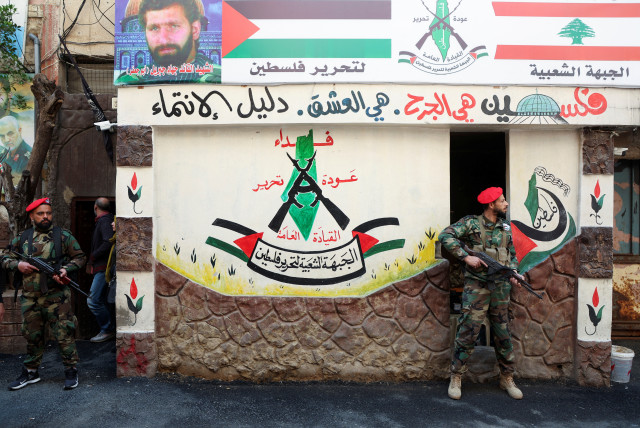Palestinian terror group blames Israel for overnight airstrike on Lebanon-Syria border

A PFLP-GC official said there were five “martyrs” and 10 wounded after the incident on the Lebanon-Syria border.
A position of the Popular Front Liberation of Palestine-General Command (PFLP-GC) terrorist organization was struck by an explosion on Wednesday, on the Lebanon-Syria border. Five terrorists were killed and the group claimed the explosion was an attack.
Arab media reports claim the incident allegedly happened near the village of Qousaya, in Lebanon on the Syrian border, overnight or in the early morning. However, there was no video footage verification of the time of the incident, by press time.
Reports say the explosion took place overnight or in the early morning, but there was no video to corroborate the time. The Alma Research and Education Center, which covers security issues in the north, noted online that “Israel is denying any involvement. It is highly probable that this is a local accident of an explosion, probably ammunition, possibly rockets. The organization, for its part, of course, blames Israel for the explosion.” The PFLP-GC denied that it was an “internal explosion.”
According to the pro-Syrian regime outlet Al-Mayadeen, an official from the PFLP-GC said there were five “martyrs” and 10 wounded after the incident and accused Israel of “aggression.”
Who are the PFLP-GC terrorist group?
The PFLP-GC is a Palestinian group founded in 1968 by Ahmed Jibril, which split from the PFLP. It was involved in terrorism in the 1970s and 1980s and during the Syrian civil war worked closely with the Iranian-backed Assad regime. It was involved in battles in the Palestinian Yarmouk camp areas where it is based.
Pro-Syrian regime groups such as Liwa al-Quds and also the Iran-backed Palestinian Islamic Jihad both have members in Syria and have threatened Israel from Syria in the past.
What was the incident that happened to the PFLP-GC on the Lebanon-Syria border?
Photos posted online showed a damaged vehicle, and what appears to be an entrance to a bunker as well as a portion of ground that appeared to have been ripped up by some kind of explosion. What looked like tubes of several unexploded old shells appeared in one photo, which could indicate this was an arms cache of the PFLP-GC.
It was not clear from the photos that this explosion had recently happened or what exactly had happened. There did not appear to be any other video or photos of the wider area, leaving questions as to what had happened.
A report in the Arabic at Quds Daily said that five Palestinians were killed “in the early hours of Wednesday morning, in Israeli raids on a site of the Popular Front - General Command, near the Lebanese border with Syria. According to sources, the raids were carried out by the Israeli Air Force, which fired several bombs at the training site of the General Command. And medical sources indicated that there are many wounded in the Israeli bombing. Israeli military sources denied that any attack had been carried out last night,” the Arabic report said.
Qousaya is located around 70 kilometers north of Israel’s northern border. It is across the border from the Zabadani area of Lebanon. During the Syrian civil war, there were important operations here where the Syrian regime and Hezbollah cooperated to fight Syrian rebels.
In 2019, social media reports also claimed there was an airstrike in Qousaya that targeted a PFLP-GC site. Lebanese president Michel Aoun condemned the incident at the time. Anadolu media reported at the time that “three explosions were heard at military posts of the Popular Front for the Liberation of Palestine (PFLP) group in the Qousaya area in eastern Lebanon, with a Lebanese official accusing Israel of being behind the incidents.”
The incident comes in the wake of tensions with Hezbollah and threats by Hezbollah terror leader Hassan Nasrallah. In addition, it comes after rocket fire over Passover from Lebanon carried out by Hamas and also after an incident in Megiddo in northern Israel in which an infiltrator passed through Hezbollah-controlled areas to get to Israel. In 2020 Hezbollah-Israel tensions rose briefly after Hezbollah claimed an airstrike struck a jeep in the border town of Jdeidat Yabous.
PFLP-GC official Anwar Raja was a key backer of the Syrian regime. In 2013 he said “Now despite all the efforts made to calm down the situation in Yarmouk camp and start a ceasefire in there, the only solution is immediate and rapid military action,” he said according to Iran’s Fars News. He has also denied the Holocaust. He was quoted by Al-Mayadeen on Wednesday after the alleged incident in Lebanon.
Reuters contributed to this report.
Jerusalem Post Store
`; document.getElementById("linkPremium").innerHTML = cont; var divWithLink = document.getElementById("premium-link"); if (divWithLink !== null && divWithLink !== 'undefined') { divWithLink.style.border = "solid 1px #cb0f3e"; divWithLink.style.textAlign = "center"; divWithLink.style.marginBottom = "15px"; divWithLink.style.marginTop = "15px"; divWithLink.style.width = "100%"; divWithLink.style.backgroundColor = "#122952"; divWithLink.style.color = "#ffffff"; divWithLink.style.lineHeight = "1.5"; } } (function (v, i) { });

